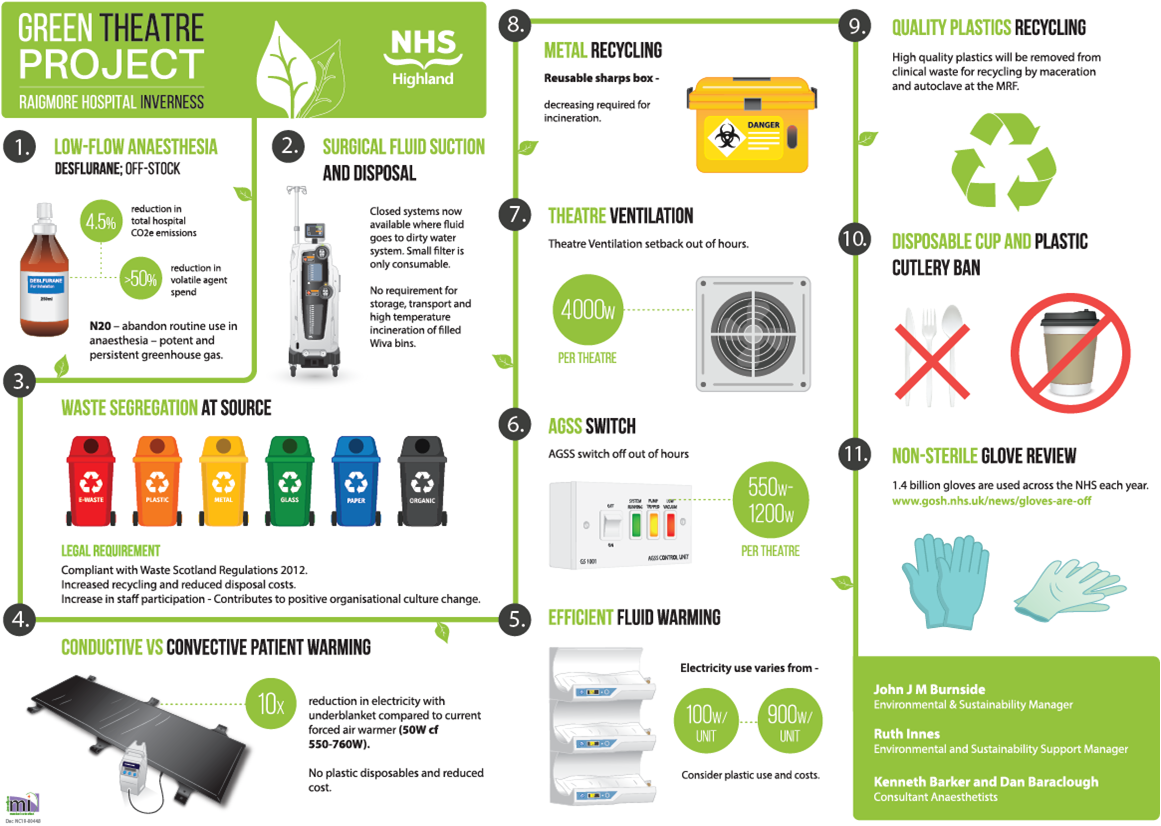Green Theatre Project: Improving the carbon footprint of surgery
NHS Highland, Inverness, United Kingdom
Case study summary
By removing high-emissions anesthetics from operating theatres and implementing low-flow anesthesia machines, Raigmore Hospital significantly reduced emissions produced by their operating theatres. This initiative was implemented as a part of the Green Theatre Project, which consists of 11 actions to make operating theatres more sustainable. The project was so effective that it was integrated into the NHS Scotland climate emergency and sustainability strategy for 2022 through 2026 as the national green theatres program.
Demographic information
Part of NHS Highland, Raigmore Hospital is located in Inverness in the Highlands of Scotland. It is an acute service district general hospital with 450 beds, 12 main theatres, and suites for endoscopy, radiology, cardiology, and other services. It has a labor suite serving 2,000 births per annum. A new national treatment center associated with the hospital containing five more theatres is currently under construction nearby. Three rural general hospitals and many community hospitals around the Highlands refer to Raigmore Hospital for specialist services. Priorities for the health board include equity of access to services across income and geographical boundaries, health promotion and disease prevention, and the effects of climate change on public health.
The issue
The NHS Scotland climate emergency and sustainability strategy recognizes surgical theatres as a high-energy and carbon-intensive area producing a significant quantity of single-use and pharmaceutical waste. An operating theatre can produce 2,300kg of anesthetic gas waste and 230kg of sharps waste annually (NHS Scotland, 2022). Hence, surgical theatres are a key target for achieving our ambitious net zero strategy. Recognizing climate change as a public health emergency and acting to mitigate the effects will help embed equity of access to health services in the future.
In 2016, an anesthetist would use a high amount of nitrous oxide (N₂O) and desflurane daily, producing a carbon footprint of 1,436kgCO2e per eight-hour workday, equivalent to driving more than 4,500km in an average car. Inspired by the work of Dr. Tom Pierce, a cardiac anaesthetist at University Hospital Southampton, the Green Theatre Project was launched at Raigmore Hospital to create more sustainable surgical theatres.
Hospital goal
- Make surgical theatres more sustainable
- Reduce the use of nitrous oxide and desflurane in theatres
- Use less polluting anesthetic gases, such as sevoflurane
- Reduce the waste produced in surgical theatres
- Reduce surgical theatres' energy consumption

The work being done in NHS Scotland to reduce the harm from medical gases is world leading. It illustrates the way in which grassroots improvements can be scaled up to, and supported at, national level to ensure lasting change that benefits our environment and society as a whole. I believe that Scotland will continue to lead the way in sustainable care and am confident that other countries in Europe and beyond will be able to learn from our successes, as we continue to learn from others.
Sustainability strategy implemented
The Green Theatre Project started with the removal of high-emissions anesthetics and implementation of low-flow anesthesia machines in one surgical theatre by one clinical team and led to a nationwide program to combat climate change.
Within three years, the project has significantly reduced desflurane use, lowering emissions equivalent to driving 9 million km in an average car per year. This work has continued on a national level through the Scottish government’s national green theatres program.
To support other health care professionals across Scotland carrying out similar initiatives, the hospital established the Green Anaesthesia Scotland grassroots network (@GreenAnaesScot).
Implementation process
The Green Theatre Project uses 11 measures to create more sustainable theatres reducing their climate impact. The project tackles a variety of issues, such as reducing energy consumption by switching off theatre ventilation and reducing waste through a ban on disposable cups and plastic cutlery.
The Green Theatre Project promotes low-flow anesthesia to reduce the impact of surgical theatres on the environment. To support the implementation of this measure, Raigmore Hospital limited access to certain anesthetics simply by removing them from anesthetic machines and making them harder to access, leading to the cessation of desflurane use and replacement with sevoflurane. Using this gas combined with new machines delivering low-flow anesthesia significantly reduced anesthetists’ carbon footprint. Nitrous oxide (N₂O) use also fell to low levels during this exercise. For an eight-hour workday, the use of desflurane and N₂O / O2 at 2l/min produces 1,436kgCO2e. In comparison, a sevoflurane air/O2 mix at 0.4l/min produces 99.7% fewer emissions at 4.8 kgCO2e.

Among other measures, environmental officers and medical and nursing staff developed and introduced a new collection and disposal method for surgical suction fluid. Formerly, surgical suction fluid was collected in VacSaxs (small plastic containers with a gelling agent), and then disposed in large plastic containers, so-called Wiva bins. These were collected from the hospital, transported by heavy goods vehicles, and incinerated at high temperatures, burning liquid and plastic. For the past three years, the hospital has moved to the Neptune suction system, a closed system where the fluid is sent to a dirty water system and does not require storage, transport, or high-temperature incineration.

Sustainable care is a vital component of NHS Scotland’s Climate Emergency and Sustainability Strategy, which will help to ensure that Scotland has a net zero health service by 2040. The medical gases project presented here is at the forefront of this work. Significant 'wins' have already been realised, most notably the identification and reduction of huge amounts of N2O loss and, of course, Scotland becoming the first country in the world to remove desflurane from national procurement contracts. The significance of this work cannot be overstated and I am confident the ongoing work will continue to deliver for the health system and our planet.
Tracking progress
By tracking pharmacy procurement data, the phase-out of potent and persistent greenhouse gases such as desflurane and a reduction in N₂O use showed a reduction in total hospital CO2e emissions of 4.5% and resulted in 50% savings on volatile agent spend.
The project's success is testified by NHS Scotland's decision to incorporate the Green Theatre Project into its climate emergency and sustainability strategy.
Progress achieved
- Reduced carbon footprint.
- Significantly reduced emissions produced by anesthetic gases, such as desflurane and nitrous oxide, in 2019.
- Establishment of the grassroots group Green Anaesthesia Scotland, with wide-ranging benefits in cooperation amongst colleagues.
- Breaking down barriers between health care groups such as clinicians and engineers to allow a full discussion of changes in clinical practice.
- Incorporating the Green Theatre Project into the NHS Scotland climate emergency and sustainability strategy as the national green theatres program.
- Significant cost savings associated with the discontinuation of desflurane procurement, which as a “green dividend” can be allocated to other environmental measures.
Challenges and lessons learned
The involvement of all groups of hospital staff and their understanding of the issue was essential for the success of the project. Including management personnel and hospital board leadership will be essential to spread these actions to other hospitals.
Next steps
The Green Theatre Project has now become the national green theatres program. The measures initially implemented at Raigmore Hospital will be scaled up and implemented across the Scottish health care sector. The project identified more than 50 distinct actions grouped into three themes – structural, system and equipment, and clinical practices – that are currently being prioritized into achievable actions. Networks of nurses, doctors, managers, and members of every Scottish health board are supporting implementation.
As well as addressing old habits, it is crucial to look for innovations. The National Green Theatres Program is now linked to the Medical Device Manufacturing Centre at Herriot-Watt University. The program is looking to work with various industries to minimize significant health care environmental effects. Two local pilot projects have been launched regarding upstream and downstream water provision.
Links
- Climate Emergency and Sustainability Strategy 2022-26 (NHS Scotland, 2022)